
Trackmania Sunrise
Written by: Rik
Date posted: January 24, 2015
- Genre: Racing
- Developed by: Nadeo
- Published by: Digital Jesters
- Year released: 2005
- Our score: 7
The main action of a typical 00s racer usually comes packaged with a number of superficial embellishments: licensed chart hits, an unnecessary narrative involving a cocky young upstart, and a condescending tutorial of some kind (possibly narrated by a benevolent NPC). As for the racing itself, you’ll almost certainly start with a crap car that will need to be upgraded multiple times during your quest to win roughly 10,000 very similar races, many of which you’ll be forced to repeat after leading for 90% of the time before crashing on the final lap and watching as the AI mysteriously catches up to you and snatches victory away at the last second.
Trackmania Sunrise is the antithesis of that template, instead offering arcade racing pared down to its base elements. There’s no background, no context: you choose a race from the menu and get started. There are 3 environments with a different car for each, and while they all have different handling models, you can’t customise anything about them, except for the colour. Control is as simple as placing a single clawed hand over the four arrow keys, and many races are completed in less than a minute, with your only opponents the ghostly on-track representations of the times to beat.
What Sunrise does have is a whole heap of content, with races and challenges spread across a variety of game modes. Race is a standard time trial, on pre-built tracks; while on Puzzle, you need to build them yourself before you race. Platform races aren’t about lap times, but the number of occasions on which you have to reset yourself on the track. Crazy, meanwhile, asks you to beat the same track a number of times, eliminating one of 12 ghosts as you go. Medals await you, depending on your performance: Gold represents mastery; Silver, competence; and Bronze is more of a “well done for getting round, you dummy.”
Puzzle is apparently beloved by fans of the series, although not, sadly, by me. You’re given a partially-built track, with a start and finish line, and a number of checkpoints, and you have to figure out the best way to connect them using the limited number of pieces at your disposal. Once you’ve done that, you have to race on the track you’ve built to see if you can beat the medal times. The combination of puzzling and racing sounds promising: you can’t win by only being good at one part – you have to be able to think and drive – but my problem is that it’s just not what I want from a racing game (and thinking isn’t my strong suit at the best of times).
Similarly, the Platform mode attempts to combine driving with the precision jumping of a platform game. It’s an interesting idea, and perhaps plenty of fun for some people, but for me the whole thing seems to be an exercise in precision-engineered frustration. If you enjoy repeatedly failing to hit a checkpoint surrounded by water, thanks partly to a bizarre system of handling that allows you to speed up and slow down in mid-air, then this is the mode for you. Again, I’m just not sure driving and platforming go together: I think there’s a reason it hasn’t been tried much since CarVup.
Thankfully, Race is more up my street, and even if Sunrise isn’t a straight racing game, I ended up treating it as such. There are 30 races in all, with 2 sets of 5 races for each of the 3 environments and associated vehicles. (I should probably clarify that the different backdrops and cars are available across all modes, I’ve just chosen to go into more detail about them here because this is where I spent most of my time.)
The Island races take place in sports car and involve high speed, big ramps and loops, and lots of powerslides. They’re almost insanely fast at times, and for added confusion the standard behind the car view occasionally switches – deliberately, but unexpectedly – to first person to add a further sense of speed/panic. For Bay themed tracks, you swap your sports car for a 4×4, which is less nippy and also prone to rolling (in a rare concession to real-life driving). The tracks here are a little more twisty and turny, and the jumps are more about taking short cuts and finding the right angle rather than getting your speed up and your line straight, as it is on the Island races.
The third environment is Coast, and it’s probably worth pointing out at this stage that all of the environments are generally doused in bright sunshine and surrounded by extremely blue water – although there are also nighttime races – with very little to distinguish each at first sight, except for the type of vehicle being used. Anyway, here the emphasis is less on jumps and stunts, and more on the traditional driving game staples of braking in a straight line and accelerating through corners. The slightly slippery handling of the roadster comes as a shock after the extremely forgiving model used for the other two vehicles, but once you get used to it, there’s an extra sense of satisfaction to be derived from the feeling that you’re actually handling a car, and the Coast races ended up being my favourite.
The final mode, Crazy, is a suitably mad (and intermittently enjoyable) twist on the Race format, in which you face a series of increasingly tight time challenges on the same track. All of the 12 ghost cars representing the target times accompany/distract you and as you beat each one they’re replaced by your own ghost. There’s an overall time limit set, and each time you fail to beat the target time and have to have another go, you lose ground overall. Needless to say, to get the gold medal you can’t afford too many mistakes.
At its best, Trackmania Sunrise is thrilling stuff. If there’s a race or challenge that you feel you can beat if you just have one more go, you’ll keep playing it over and over again. The game is designed for you to do so, with simple controls, forgiving handling, and a quick restart key – hitting Delete when you crash or mess up (which you will) whizzes you back to a fresh attempt in an instant. Stripping back all of the sundry nonsense means you don’t have to endure cut scenes or menus and can just get on with the business of racing. That isn’t to say no attention has been paid to presentation, because it looks great (although it helps if you like motion blur), and while the music isn’t exactly memorable or recognisable, it also serves its purpose as superficially catchy but otherwise unobtrusive background noise.
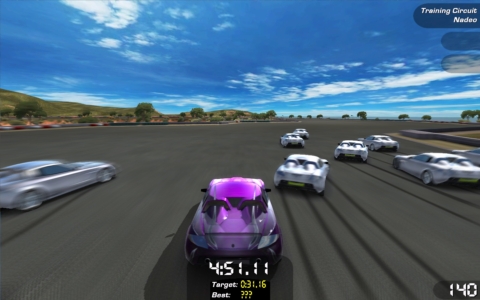
In Crazy mode. Fortunately these ghosts don’t actually get in your way, although they do kind of mess with your mind a bit.
Mention must also be made of the construction kit, with which you can make your own challenges, Stunts-style, although you do have to buy pieces for the kit by earning points (‘coppers’) in the main game. And, while we’re talking about Stunts, although it’s not really fair to treat it as a modern update when no-one ever said it was intended as such, it’s worth a quick comparison. Sunrise easily sees off the challenge of the rather mundane Crashday, but doesn’t really satisfy as a spritual successor to 4DSD. My main complaint would be that the cars don’t handle like cars, except for on the Coast races, and in Stunts, I always enjoyed the tension created by the possibility of a race-ending crash, rather than bouncing off the scenery, as you do here. As for the construction kit, I don’t know why, but I didn’t feel any compulsion to try it out for very long, but I’m perfectly willing to accept that it’s the dimming of my own creative urges, rather than any fault of the game, or the editor, that’s responsible.
For all its good qualities, Trackmania Sunrise never really grabbed me totally, and I was left with the feeling I should have liked it more than I did. It was the same with the original Trackmania, which I enjoyed in fits and starts, but then left alone for months and years without a second thought. (Incidentally, I tried to get it working for this review but for some reason it just caused my PC to crash and restart, I don’t know why.)
If I had to put my finger on it I’d say that the fun/frustration factor is just a little too skewed towards the latter. For every race that has you slapping your fingers on the keyboard for another go, there’s another that has you puffing out your cheeks and saying, well, bollocks to this. Medals on individual tracks come easily enough, but to make progress and unlock later races and events you need to complete ‘Serie Cups’, in which you must complete a series of races under the medal time without the option of restarting. I’ve made peace with the fact that a Gold cup is beyond a man of limited patience and reflexes such as myself. For all that Sunrise eschews the standard racing clichés, repetition isn’t one of them – it’s hard-wired into the game.
Still, even if you don’t enjoy absolutely every inch of Sunrise, there’s enough in just one of the modes on offer to make for a good time. The moments when you work out how to master a particular track are undeniably satisfying, and you can’t help but admire the craft that’s gone into putting each of them together. Despite the variety on offer, there’s nothing confused or muddled about Sunrise – it is the result of developers who know exactly what they want to achieve working to deliver the fastest, smoothest, leanest version of that vision. How much of it is to be admired rather than enjoyed depends on your own preferences. Trackmania Sunrise works as a pure arcade racer, but if you can get into the puzzle and platform modes as well, you’ll really get the most out of it.

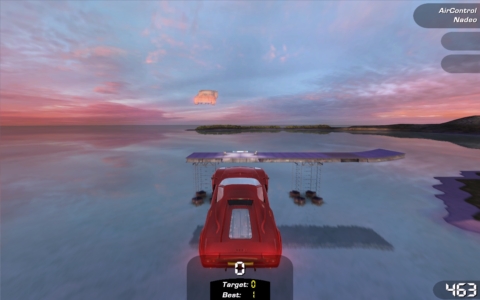
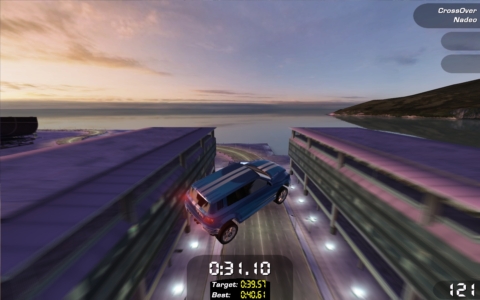
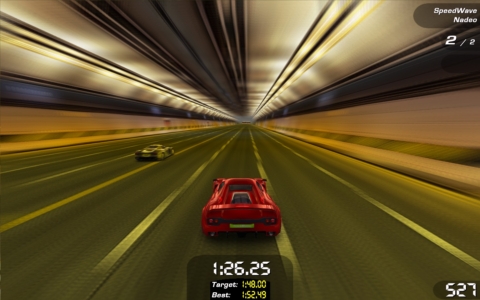
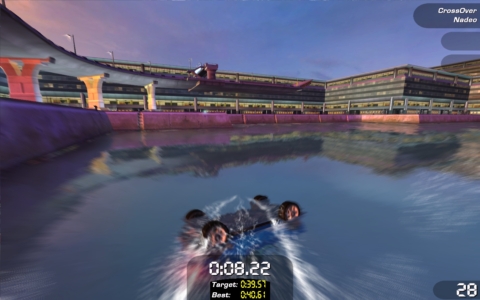

 Posts
Posts